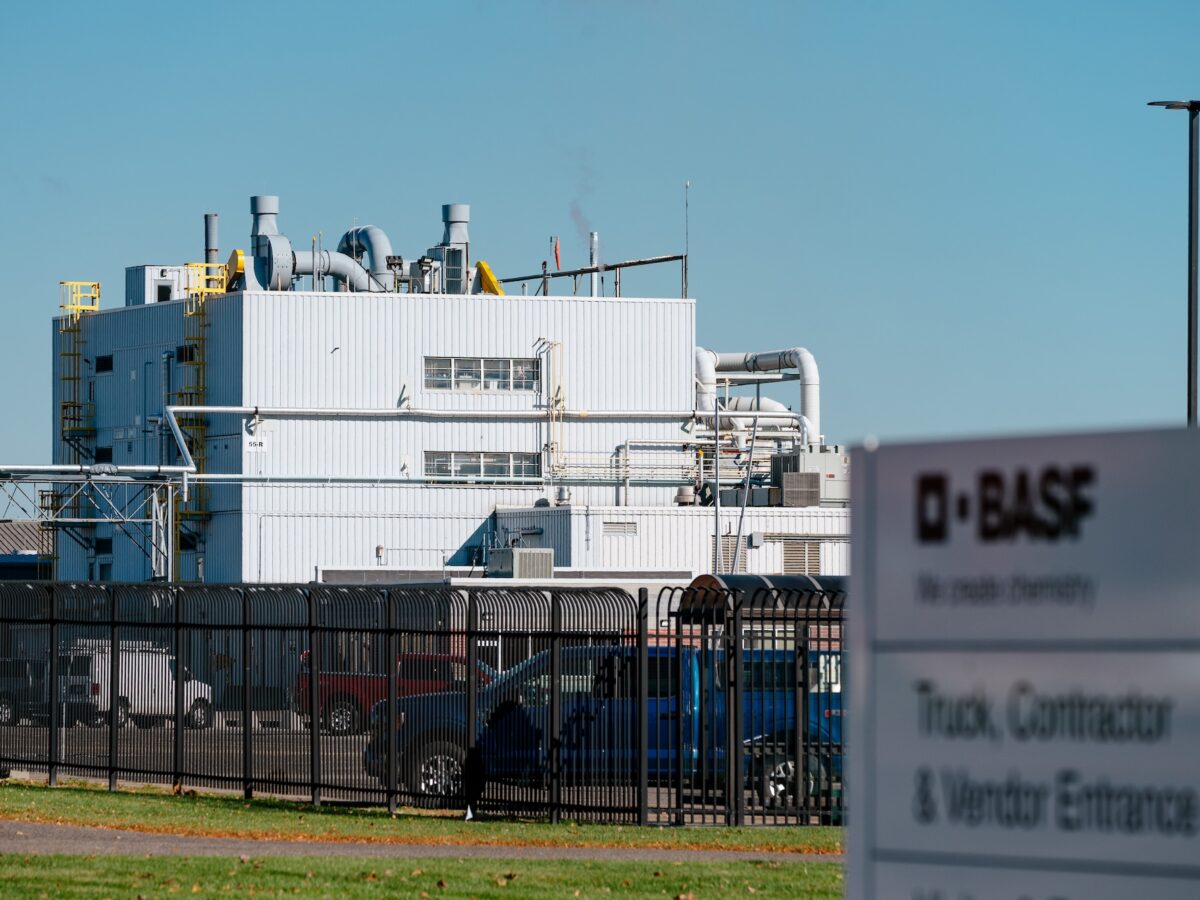Overview:
-Survey raises concerns about Wyandotte's ability to protect water customers from BASF pollution and other contaminants, water expert says.
-Wyandotte suspended fluoridation of its drinking water, according to the state report.
-Mayor says at April meeting that Wyandotte's water system "remains safe, well-monitored, well-managed."
An April survey of Wyandotte’s water system revealed numerous problems that state regulators say pose an “immediate health risk to consumers of water.”
State regulators found “significant deficiencies” with Wyandotte Municipal Services’ treatment, distribution, and storage of drinking water as well as problems with the system’s oversight, according to an April 30 report from the Michigan Department of Environment, Great Lakes, and Energy’s Drinking Water and Environmental Health Division. The system serves approximately 12,000 people, according to its website.
The deficiencies listed in EGLE’s survey don’t have a “direct impact on the quality of the water that we provide,” and the utility has begun to take action to address these problems, Wyandotte City Administrator Rob McMahon said in a statement.
“The water provided to Wyandotte residents by Wyandotte Municipal Services (WMS) has always met and or exceeded all standards set by EPA and EGLE,” McMahon said.
Wyandotte hasn’t treated its water with fluoride since 2017, according to the state survey. Wyandotte’s own annual water quality reports say the city has not met recommended fluoride levels since 2014.
EGLE regulators say if there is a prolonged interruption in fluoridation, the water system should notify residents so they can make informed health decisions. Experts say fluoride treatment is an important strategy for improving oral health. Nearly 90% of Michigan residents had access to fluoridated water in 2019, according to state data.
Despite EGLE’s findings, the Wyandotte Municipal Services webpage says fluoride is added to water as part of the treatment process to prevent tooth decay.
Wyandotte officials did not respond to questions from Planet Detroit about the suspension of fluoridation in the city.
Wyandotte’s drinking water intake downstream of polluted BASF site
The information coincides with growing concern over BASF’s ongoing pollution of the Detroit River. Groundwater contaminated with PFAS, arsenic, mercury, and other chemicals flows from a BASF property into the Detroit River roughly 1,700 feet from Wyandotte’s drinking water intake.
EGLE officials have said the discharge violates a 1986 consent order. BASF disputes EGLE’s assertion regarding the consent order and said it is in compliance, the Detroit Free Press reported earlier this month.
Wyandotte officials have repeatedly said the city’s water meets state and federal water quality standards.
Wyandotte Mayor Robert DeSana pushed back forcefully on what he frames as undue suspicion of the city’s drinking water at a recent online meeting.
“Wyandotte’s water system remains safe, well-monitored, well-managed,” DeSana said during an April 30 Environmental Protection Agency meeting to address the BASF contamination.
This comment was made the same day EGLE’s letter identified “deficiencies” in Wyandotte Municipal Services’ management and operations.
DeSana did not respond to a call made to him for comment on this story.
The EGLE report said Wyandotte’s Asset Management Plan finds 40% of the system has “significant deterioration.” Tennis balls, beverage containers, and insects were found in one of the city’s drinking water reservoirs in 2019 and 2022 inspections. EGLE noted “large, unprotected openings” presenting “sanitary hazards” in another reservoir.
“The fact that they’re downstream of this very large chemical plant that’s not in compliance with its consent order … makes it more vulnerable than usual,” Elin Betanzo, founder and president of Detroit-based Safe Water Engineering LLC, said of Wyandotte’s water system.
Wyandotte saw a spike in levels of several types of PFAS in its water in August 2019, before the state and EPA instituted drinking water limits for some types of PFAS. City officials said Teflon tape used on pipes in the filtration plant was to blame for the high PFAS levels.
The EGLE report does not connect any deficiencies to the polluted BASF site.
Repeated warnings on Wyandotte water
A 2020 survey revealed many of the same issues identified in the report released last month.
“This is obviously a very challenged water system,” Betanzo said. All the components in the survey with direct impact on water quality, such as treatment and distribution, are compromised in some way, she said.
EGLE spokesperson Scott Dean told Planet Detroit that Wyandotte’s ongoing problems indicate a lack of technical, managerial, and financial (TMF) capacity.
The state survey says TMF is essential for allowing water systems to “consistently provide safe drinking water to the public.” Systems lacking TMF capacity may be ineligible for state loan assistance.
“EGLE has various enforcement tools and will be meeting with the city to establish a formal corrective action plan in the near future,” Dean said.
Wyandotte has until May 30 to contact EGLE about corrective action. Dean said on May 28 the agency has yet to receive a response from the city about the water system survey.
The situation also underscores the barriers residents face when accessing basic information about their local water systems. EGLE did not publish the 2020 and 2024 surveys, which were obtained through Freedom of Information Act requests.
MORE REPORTING FROM PLANET DETROIT
BASF Detroit River pollution: Environmental regulators discuss remedy for contaminated groundwater
Environmental advocates are calling for urgent action as regulators outline plans to curb pollution from BASF’s Wyandotte facility, which discharges 60 gallons of contaminated groundwater into the Detroit River every minute.
Highland Park residents face boil water advisories as city replaces century-old pipes
Highland Park resident Runae Ford said the latest boil water advisory couldn’t have come at a worse time: the end of the month. “At least do something about our water bill,” she says. “We’re paying for something we cannot use.”
BASF pollution: Environmental groups secure public health assessment for Wyandotte
State and federal authorities will assess the impacts of BASF’s ongoing pollution on air, water and soil.
As safeguards fail, drinking water risks grow, expert says
Wyandotte’s problems with key parts of its water system are critical because it’s impossible to test for every possible contaminant, Betanzo said. That means regulators need to look at water treatment and other processes to ensure the system is protecting public health.
Among the issues regulators flagged are problems with Wyandotte’s coagulation process: specifically, the city’s ability to monitor how a key chemical is mixed. This chemical helps particles clump together so they can be filtered out. Properly managed coagulation is a critical step for removing particles and microbial contaminants, Betanzo said.
The survey also highlighted the city’s failure to enact a residential cross-connection control program. Such a program could entail requiring and inspecting backflow preventers to keep bacteria from sprinkler systems or pesticides applied through garden hoses from flowing back into the drinking water system during low-pressure events, Betanzo said.
Each one of these issues may not be alarming on its own, but taken together, they signify a threat to the multiple barriers needed to ensure safe drinking water, Betanzo said.
“Sometimes we talk about Swiss cheese and whether the holes line up with each other. The more holes you have, the more contaminants are going to get through,” she said.
“I see some very hole-y Swiss cheese here.”
‘An extremely vulnerable intake’
The source of Wyandotte’s drinking water lies within a critical assessment zone, which state regulators define as an area near a water intake that is highly vulnerable to pollution.
The survey mentions the intake only once. But Betanzo said the intake’s vulnerability is a fundamental concern that deserves more focus.
“Dealing with the fact that you’ve got an extremely vulnerable intake is where you start,” she said.
Wyandotte Municipal Services acknowledged this risk in its 2023 Water Quality Report, stating: “Our source was determined to be highly susceptible to potential contamination.”
The utility did not specify the contaminants to which the intake may be vulnerable, offering only a general statement that “our filtration plant has historically provided satisfactory treatment of this source water to meet drinking water standards.”
The state’s survey suggests Wyandotte undertake a Source Water Intake Protection Program, which could entail addressing potential contamination sources, developing contingency plans for dealing with threats to the intake, adding source water protections, and identifying methods for public outreach.
Betanzo would also like to see expanded testing of raw water to quickly detect contamination threats, saying it’s one of the most important things vulnerable water systems can do.
Wyandotte tests raw and treated water for volatile organic compounds, PFAS chemicals, and mercury on a quarterly basis, EGLE’s Dean said.
Betanzo said that Ann Arbor — which is dealing with PFAS contamination from the Huron River, its drinking water source — samples for PFAS every two weeks.
Lack of public outreach on fluoride, other issues ‘unacceptable’
Wyandotte Municipal Services lowered the amount of fluoride in the city’s water in 2010 from 1.1 milligrams per liter to 0.7 milligrams per liter, according to the city’s 2010 annual water quality report.
A 2011 report from the Times-Herald newspaper cited chemical costs and a debate over fluoride’s tooth decay prevention versus its possible health risks as reasons for the change. The 0.7 milligrams per liter level matches the U.S. Public Health Service’s recommendation for drinking water fluoridation.
The city’s annual water quality reports contradict the information on the city webpage that states Wyandotte’s water is fluoridated. These reports show the last time fluoride met the recommended level was in 2014, when it was detected at 0.77 milligrams per liter.
The 2015-2018 reports say fluoride was “shut off during [a] rehab project.” Reports in subsequent years show fluoride levels as “ND,” except for 2022, when it was detected at 0.04 milligrams per liter, below federal guidelines.
Notifying Wyandotte customers of the lack of water fluoridation may be especially important because fluoride protects against tooth decay. The EGLE report says it’s important to notify residents that fluoridation has been discontinued, noting that local pediatricians and dentists make prescription and treatment decisions based on their understanding of fluoride levels.
EGLE does not have the authority to notify city customers about the halt to fluoridation, said Dean, the regulatory agency’s spokesperson.
When asked whether EGLE would hold a public meeting or otherwise notify residents about issues addressed in the survey, Dean said: “There is no requirement or plan for EGLE to hold a public meeting, but we are happy to do so if requested by the city or community.”
Betanzo calls the lack of public transparency around drinking water system problems “unacceptable,” but not unique. Working with Planet Detroit, she has used Freedom of Information Act requests to find 114 consent agreements between EGLE and state water systems over the last decade.
“In most cases, the general public knows absolutely nothing about [these].”
EGLE has a responsibility to hold a public meeting or issue a press release to translate the technical information in the survey into language the broader public can understand, Betanzo said.
“The alternative that we’re getting right now from the Wyandotte water department is ‘everything’s fine, we got this,'” she said. “This [survey] doesn’t tell me everything’s fine.”





